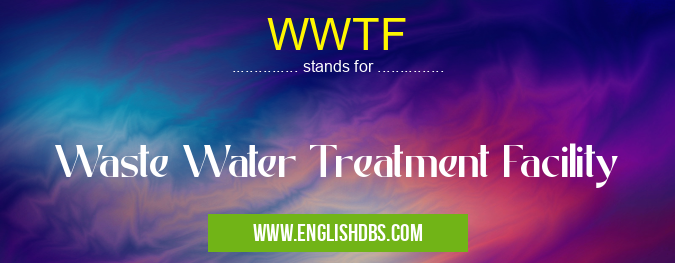What does WWTF mean in ENVIRONMENTAL
The abbreviation WWTF stands for Waste Water Treatment Facility. A Waste Water Treatment Facility is a facility where wastewater is treated to remove pollutants and contaminants so that it can be returned safely to the local environment.

WWTF meaning in Environmental in Governmental
WWTF mostly used in an acronym Environmental in Category Governmental that means Waste Water Treatment Facility
Shorthand: WWTF,
Full Form: Waste Water Treatment Facility
For more information of "Waste Water Treatment Facility", see the section below.
Essential Questions and Answers on Waste Water Treatment Facility in "GOVERNMENTAL»ENVIRONMENTAL"
What types of pollutants are removed in a WWTF?
Pollutants such as heavy metals, chemicals, and organic matter are removed in a WWTF. Additionally, bacteria, viruses, and other microorganisms can also be trapped and destroyed during treatment.
How does a WWTF work?
A WWTF typically consists of several different stages which involve physical processes, chemical treatments, and biological processes. These stages may include screening of solids, sedimentation of suspended solid particles, aeration of wastewater to facilitate biological growths and removal of nitrogen compounds, filtration through media like sand or activated carbon to remove small particulates from the water, disinfection using ultraviolet light or chlorine to kill remaining pathogens in the water after treatment.
How do communities benefit from having a WWTF?
Communities benefit from having a WWTF because it helps to reduce pollution levels in nearby surface waters such as lakes and rivers. This can help create healthier ecosystems for wildlife habitat and provide cleaner recreational areas for people in the community. Additionally, treated wastewater can be reused for non-potable purposes like irrigation or cooling tower makeup water.
Are there any potential environmental impacts associated with running a WWTF?
Potential environmental impacts include air pollution resulting from fossil fuel combustion used to power pumps and other equipment at the facility; discharge of sludge generated during treatment into nearby waters; release of chlorine into nearby surface water; release of greenhouse gases when organic matter is broken down anaerobically; and production of biohazards due to the presence of bacteria in wastes discharged from the treatment plant.
Final Words:
A Waste Water Treatment Facility is an important part of protecting our environment by removing pollutants from wastewater before it is returned back into our local environments and providing clean recreational areas for people in the community. However, it is important to consider potential impacts associated with operating a WWTF such as air pollution and wastewater discharge when evaluating this type of facility.
